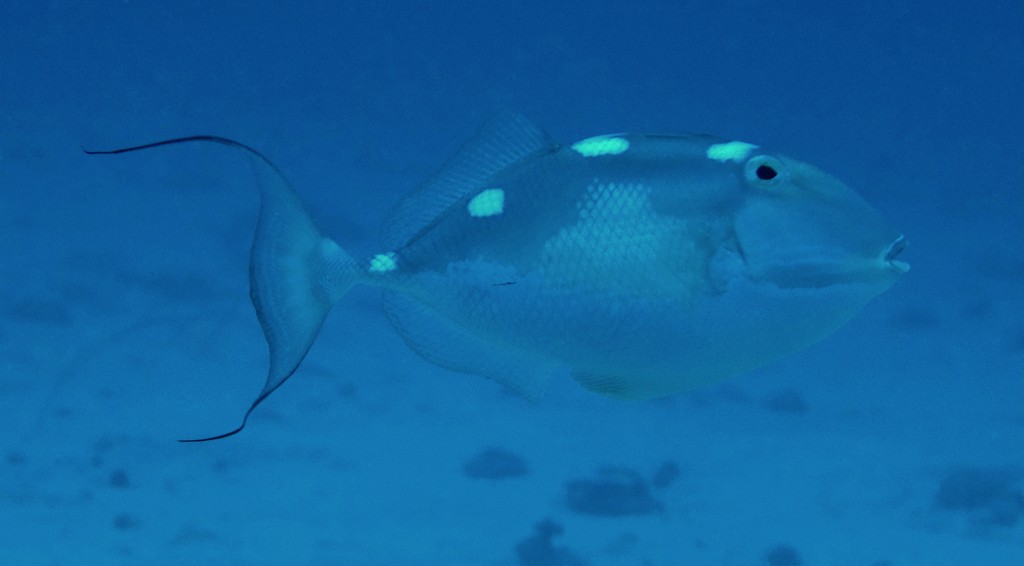ABALISTES FILAMENTOSUS - (MATSUURA & YOSHINO, 2004)
Picture courtesy of: Alain Daoulas
Actinopterygii (Gigaclass) > Actinopteri (Class) > Teleostei (Subclass) > Tetraodontiformes (Order) > Balistoidei (Suborder) > Balistidae (Family) > Abalistes (Genus)
Baliste à filaments, Hairfin Triggerfish, イトヒキオキハギ, 絲鰭寬尾鱗魨, فریباماهی بالهمویی,
Description
Dorsal spines (total): 3; Dorsal soft rays (total): 25-27; Anal soft rays: 22-25; Pectoral fin rays: 14-15 (usually: 14); Body scale rows: 33-39; Head scale rows: 25-32. Upper and lower rays of caudal fin greatly produced in filaments. Cheek with 3-4 longitudinal grooves. Max. length: 32.5 cm SL. Max. published weight: 1.4 kg. Depth range: 20 - 180 m.
Biology
Inhabits mud and silt sand bottoms. Adults on deep coastal slopes and usually seen swimming high above the bottom, sometimes found in estuaries. Juveniles in sheltered coastal bays and estuaries with outcrops of rubble or debris on open substrates. Oviparous, distinct pairing during breeding.
Similar species
Abalistes stellatus (Anonymous, 1798) - Reported from New Caledonia. Link to the species (here).
Actinopterygii (Gigaclass) > Actinopteri (Class) > Teleostei (Subclass) > Tetraodontiformes (Order) > Balistoidei (Suborder) > Balistidae (Family) > Abalistes (Genus)
Baliste à filaments, Hairfin Triggerfish, イトヒキオキハギ, 絲鰭寬尾鱗魨, فریباماهی بالهمویی,
Description
Dorsal spines (total): 3; Dorsal soft rays (total): 25-27; Anal soft rays: 22-25; Pectoral fin rays: 14-15 (usually: 14); Body scale rows: 33-39; Head scale rows: 25-32. Upper and lower rays of caudal fin greatly produced in filaments. Cheek with 3-4 longitudinal grooves. Max. length: 32.5 cm SL. Max. published weight: 1.4 kg. Depth range: 20 - 180 m.
Color
Dark brown mottled with irregular pale markings above with 3 white blotches on back, first below base of first dorsal fin spine, second immediately behind third dorsal fin spine, and third below middle of soft dorsal fin; Cheek greenish-brown with 3-4 longitudinal dark brown grooves; Ventral half of body pale or white; Dorsal half of snout brown; First dorsal fin with large dark brown area on proximal part, pale distally with brown lines; Soft dorsal and anal fins pale with 4-5 horizontal wavy brown lines; Base of soft dorsal fin dark brown but base of anal fin white; Base of caudal fin dark brown dorsally, white ventrally; Caudal fin brown or yellowish brown proximally, paler distally with 3-4 vertical wavy brown lines; Upper and lower filamentous rays dark brown.
Etymology
Etymology
Abalistes: from Latin prefixe, ab-, a-, abs-, au- = away from + from Latin, ballista = to throw, I throw. Referring to the first backbone that rises quickly when the animal is threatened or when hunting. Originally, the word "catapult" refers to an arrow-throwing device, while the term "ballista" refers to a stone-throwing machine, but the meanings of the two terms were reversed from the fourth century AD onwards, leading to some confusion in the terms. The fact that the word "catapult" (which gave rise to a verb: "to catapult") became a generic term, which, at certain times, indiscriminately refers to all siege engines from the ballista to the trebuchet, further obscures the terminology.
filamentosus: from Latin, fīlum = thread + from Latin suffix, -osus = full of, prone to. In reference to the filamentous rays in its caudal fin.
Original description: Abalistes filamentosus Matsuura & Yoshino, 2004 - Type locality: Ryukyu Islands, south coast of Okinawa-jima Island, off Itoman (Japan), 17 June 1982, hook and line, T. Yoshino (obtained from local fisherman).
Distribution
Original description: Abalistes filamentosus Matsuura & Yoshino, 2004 - Type locality: Ryukyu Islands, south coast of Okinawa-jima Island, off Itoman (Japan), 17 June 1982, hook and line, T. Yoshino (obtained from local fisherman).
Distribution
Eastern Indian Ocean, western Pacific: Ryukyu Islands north to Tokara Islands (southern Japan); northern Western Australia and Northern Territory (Australia), east to Coral Sea (Australia) and New Caledonia.
Biology
Inhabits mud and silt sand bottoms. Adults on deep coastal slopes and usually seen swimming high above the bottom, sometimes found in estuaries. Juveniles in sheltered coastal bays and estuaries with outcrops of rubble or debris on open substrates. Oviparous, distinct pairing during breeding.
Similar species
Abalistes stellatus (Anonymous, 1798) - Reported from New Caledonia. Link to the species (here).
Last update: 30, August 2024
